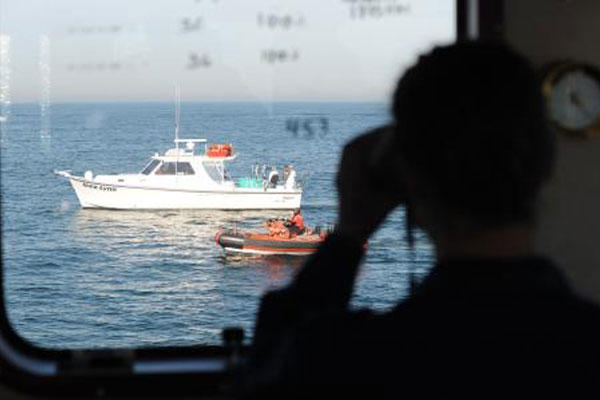The pre-dawn January morning was chilled with a light breeze while wisps of fog clung to the distant skylines of Portsmouth and Norfolk. Slowly, a golden-red sun climbed the horizon, painting the white hull of the 87-foot Coast Guard Cutter Shearwater with a soft light as the crew pulled the ship away from the pier.
The crew of the Shearwater was underway for Operation Striper Swiper, a federal and state initiative to preserve the striped bass population in federal waters — three nautical miles out from the shore and beyond to 200 nautical miles.
The Atlantic Striped Bass Conservation Act was passed by congress in 1984 with amendments in 1986 and 1991 to counteract the severe population drop of striped bass. Overfishing, pollution and loss of habitat had caused the decline of the striped bass harvest. The conservation act made it illegal to fish in federal waters, yet some fishermen choose to ignore the law.
“The goal is to enforce the striper regulations,” said Master Chief Petty Officer Stephen Atchley, the officer in charge of the Shearwater. “Depending on the time of year, there are a lot of striped bass here in the bay that fishermen catch. It's at the point where [the striped bass] move off shore to do their breeding, that is what we are trying to protect. To give them a chance to survive.”
The breeding grounds are so important for the increase in striped bass populations that catching and releasing the fish is also illegal.
“It is a really fun fish to catch and angle, particularly around the Chesapeake Bay area and up in the Hudson River area off New York,” said Lt. Cmdr. Kevin Saunders, the Coast Guard’s 5th District deputy commander response and enforcement chief. “Tons of anglers would come out and try to catch these fish recreationally, to the point that year after year we started seeing fewer and fewer striped bass.”
As the sun burned off the morning chill and haze, the Atlantic Ocean revealed numerous boaters fishing on the calm waters. Aboard the Shearwater, boarding team members donned cold-water immersion suits and tactical law enforcement gear before getting underway on the Shearwater’s small boat. The team boarded small boats at random, conducting safety inspections and looking for signs of illegally caught striped bass.
As the day wore on, recreational boaters dispersed from the area. At one point, the crew found a vessel with signs of an illegal catch, but absent the presence of a caught fish, the boarding team could only explain to the captain that targeting bass for even catch and release is illegal in federal waters.
“There are people out there who absolutely know they are doing things illegally,” said Saunders. “They will throw caught fish overboard when they see Coast Guard assets approaching."
Operation Striper Swiper is an ongoing mission for the Coast Guard along the mid-Atlantic coast. In their mission to protect and preserve the striped bass population, the Coast Guard partners with the National Marine Fisheries Service, an agency of the National Oceanic and Atmospheric Administration.
At the end of the day the crew of the Coast Guard Cutter Shearwater returned home. No illegal catches were found that day, but tomorrow the crew will continue their efforts to preserve the striped bass.

























